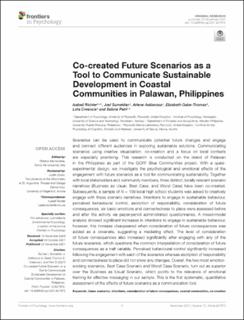| dc.description.abstract | Scenarios can be used to communicate potential future changes and engage and connect different audiences in exploring sustainable solutions. Communicating scenarios using creative visualisation, co-creation and a focus on local contexts are especially promising. This research is conducted on the island of Palawan in the Philippines as part of the GCRF Blue Communities project. With a quasi-experimental design, we investigate the psychological and emotional effects of the engagement with future scenarios as a tool for communicating sustainability. Together with local stakeholders and community members, three distinct, locally relevant scenario narratives (Business as Usual, Best Case, and Worst Case) have been co-created. Subsequently, a sample of N = 109 local high school students was asked to creatively engage with these scenario narratives. Intentions to engage in sustainable behaviour, perceived behavioural control, ascription of responsibility, consideration of future consequences, six basic emotions and connectedness to place were assessed before and after the activity via paper-pencil administrated questionnaires. A mixed-model analysis showed significant increases in intentions to engage in sustainable behaviour, however, this increase disappeared when consideration of future consequences was added as a covariate, suggesting a mediating effect. The level of consideration of future consequences also increased significantly after engaging with any of the future scenarios, which questions the common interpretation of consideration of future consequences as a trait variable. Perceived behavioural control significantly increased following the engagement with each of the scenarios whereas ascription of responsibility and connectedness to place did not show any changes. Overall, the two most emotion-evoking scenarios, Best Case Scenario and Worst Case Scenario, turn out as superior over the Business as Usual Scenario, which points to the relevance of emotional framing for effective messaging in our sample. This is the first systematic, quantitative assessment of the effects of future scenarios as a communication tool. | en_US |

